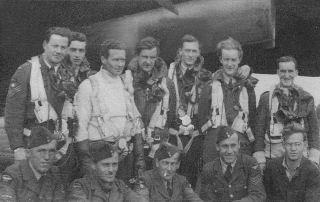It was Dec. 16, 1943, two weeks before Christmas, and Pilot Officer Lewis Percival Archibald and his seven-man bomber crew were preparing for an evening mission into Germany.
The 21-year-old — born on Aug. 14, 1922, to William and Jessie Anna of Moose Jaw — was the lead pilot of Lancaster bomber DS846, nicknamed “Old Black Magic,” which flew with No. 426 Thunderbird Squadron in the 7th Bomber Squadron. Their mission that cold evening was to attack the German capital of Berlin — the heart of the enemy’s home.
After prepping their plane, the men departed their airbase at Linton-on-Ouse in northern England at 4:22 p.m. and formed up with dozens of other bombers.
The team reached 19,000 feet and was cruising over Germany when an enemy night fighter jumped them from below and behind, riddling the plane with bullets. The bomber fell from the sky and crashed into a farmer’s field near the village of Hoyahagen, about 43 kilometres southeast of Bremen in northern Germany.
The crash killed six of the men, including Archibald, while a seventh survived and was taken prisoner.
German personnel recovered the bodies and took them to the airbase at Hoya, where they identified them. Five airmen had identity discs, while a sixth did not and was only identified through his “CANADIAN” shoulder flash.
On Dec. 19, 1943, the German army gave the Canadians a military funeral and buried them in Hanover.
Two years later, on June 15, 1945, an investigator from the Canadian military travelled to Hoya to learn more about the crash and see where the bodies were buried, according to a note on the Veterans Affairs Canada website. The investigator spoke with the keeper of church records at Hoya and discovered he should visit Hoyahagen for more information.
The sleuth spoke with the village’s mayor, who said the bomber had crashed on his farm. The mayor’s son then took the investigator to the crash scene.
“A bare patch in a field of barley showed where the aircraft had crashed, (and) with the exception of a few small pieces of metal, nothing remained,” the investigator wrote in his report.
“The Luftwaffe had carefully removed all salvable material, and two seasons of deep ploughing had almost obliterated what few pieces had been left behind (by) the Luftwaffe.”
The investigator returned to Hoya to see the airmen’s graves and found them well-kept and clearly marked with their names. He noted that the church recordkeeper’s daughter had been tending the graves and thanked her on behalf of the families.
Besides Archibald, those killed included Sgt. Raymond Atkin, Pilot Officer Harold James Hurley, Pilot Officer Joseph Leonidas Roger Rolland Lachance, Pilot Officer Norman Byng Morrison (North Battleford) and Warrant Officer Class II Jack Dunbar Newcombe.
Pilot Officer J.L. Wilson survived the crash, was taken prisoner of war, and released at war’s end.
In response to some providers blocking access to Canadian news on their platforms, our website, MooseJawToday.com will continue to be your source for hyper-local Moose Jaw news. Bookmark MooseJawToday.com and sign up for our free online newsletter to read the latest local developments.




